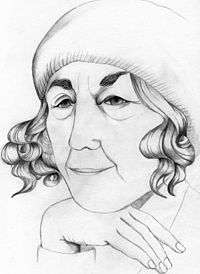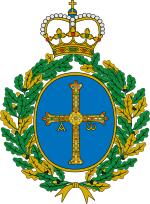Carmen Martín Gaite
Carmen Martín Gaite (8 December 1925 – 23 July 2000) was a Spanish author. She wrote in many genres, including novels, short stories, and essays. She also wrote screenplays. Over the course of her life, she won various awards, including the Premio Nadal in 1957 for Entre visillos, the Prince of Asturias Awards in 1988, the Award Premio Castilla y León de las Letras in 1992, and the Premio Acebo de Honor awarded to her life work.
Carmen Martín Gaite | |
|---|---|
 | |
| Born | 8 December 1925 |
| Died | 23 July 2000 (aged 74) |
| Spouse(s) | Rafael Sánchez Ferlosio |
| Era | 20th-century |
Biography
Carmen Martín Gaite was born in Salamanca, 8 December 1925. She was the second daughter in the marriage of José Martín López (Valladolid, 1885) and María Gaite Veloso (Orense, 1894), who got married in 1923. Her parents had met in Salamanca, where her father worked as a notary. Her maternal grandparents were from Orense and her mother was also born in this province of Spain. Her grandfather was a professor of geography and her great uncle founded the Ateneo of Orense and was a director and a publisher of the newspaper called El Orensano. The family used to spend summers on the farm of her grandparents in San Lorenzo de Piñor (Barbadás), five kilometers away from Orense. These trips were the base of her connection with Galicia and its culture. It encouraged her to write some of her works, such as Las ataduras and Retahílas.[1]
Carmen was born and grew up in the city of Salamanca. As a child, she did not attend to any school because her father, who had liberal ideas, did not want her to be educated in a religious institute. That is why she had private classes at home given by private teachers and her father, who was fascinated by the history and the literature.
The start of the Spanish Civil War stopped Carmen from attending the last two years of High School in the School Institute of Madrid, as her sister Ana had done before, so she had to do her secondary education in the Women's School Institute of Salamanca, whose environment is reflected in her novel, Entre visillos. There, she was taught by Rafael Lapesa and Salvador Fernández Ramírez. They would be future members of the Real Academia Española (Royal Spanish Academy) and would leave a mark in her literary vocation.
In 1943, she studied Philosophy at the University of Salamanca, where she was taught by Francisco Maldonado, Antonio Tovar, Manuel García Calvo and Alonso Zamora Vicente. In the first year, she met Ignacio Aldecoa and Agustín García Calvo. In those years, she contributed to the magazine Trabajos y días, where her first poems would appear. She also became interested in the theater, taking part as an actress in several plays. During the summer of 1946, she was awarded a grant by the University of Coimbra, where she strengthened her interest for the Portuguese-Galician culture.
In the summer of 1948, after finishing her degree in Romance Philology,[2] she was awarded a scholarship for further studies abroad in the Collège International de Cannes. There, she perfected her French and became familiar with a more open and more cosmopolitan society. That same year, she moved to Madrid in order to prepare her PhD thesis in XIII Galician-Portuguese chansonnier, which she would not complete. In Madrid, Ignacio Aldecoa introduced her to the literary circle of some of the writers that were part of the Generation of '50.[3] Significant members of this generation were: Medardo Fraile, Alfonso Sastre, Mayrata O'Wisiedo, Jesús Fernández Santos, Rafael Sánchez Ferlosio, Josefina Aldecoa and Carlos Edmundo de Ory.
She was married to fellow writer Rafael Sánchez Ferlosio.
Bibliography
Novels
- Entre visillos (1957) (premio Nadal)
- Ritmo lento (1963)
- Retahílas (1974)
- Fragmentos de interior (1976)
- El cuarto de atrás (1978)
- Nubosidad variable (1992)
- La Reina de las Nieves (1994)
- Lo raro es vivir (1996)
- Irse de casa (1998)
- The Back Room (2000) (Translation of El cuarto de atrás, (1978)
- Los parentescos (2001) (posthumous, unfinished)
- Usos amorosos de la posguerra española
Short stories
- El balneario (1954)
- Las ataduras (1960)
- Cuentos completos (1978)
Children's literature
- El castillo de las tres murallas (1981)
- El pastel del diablo (1985)
- Caperucita en Manhattan (1990)
Theatre
- A palo seco (1957)
- La hermana pequeña (1959)
Television
- Teresa de Jesús (see article) (1984 miniseries)
Poetry
- A rachas (1976)
Essays
- El proceso de Macanaz (1969)
- Usos amorosos del dieciocho en España (1972)
- La búsqueda de interlocutor y otras búsquedas (1973)
- El cuento de nunca acabar (1983)
- Usos amorosos de la postguerra española (1987)
- Desde la ventana (1987)
- Agua pasada (1992)
- Cuadernos de todo (2002)
Translation
- Madame Bovary (1993)
References
- Pérez, Janet. NUBOSIDAD VARIABLE: CARMEN MARTÍN GAITE AND WOMEN'S WORDS. Texas Tech University.
- Eaude, Michael (27 July 2000). "Carmen Martín Gaite". Theguardian.com. Retrieved 13 October 2017.
- "Carmen Martin Gaite - Spanish writer". Encyclopædia Britannica. Retrieved 10 May 2016.
